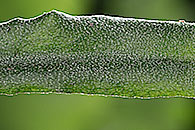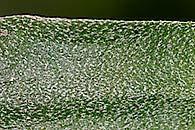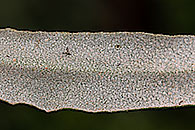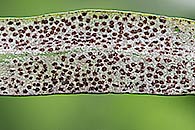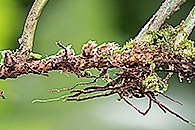Pyrrosia schimperiana (Mett. ex Kuhn) Alston
Synonyms |
Polypodium schimperianum Mett. ex Kuhn |
|---|---|
Common name |
|
Description |
Rhizome shortly creeping, 1.5-3 mm in diameter; rhizome scales dull, brown to pale grey with dark central area, margins entire, ovate to lanceolate in outline, apex acuminate, 2.8-8 x 0.9-1.9 mm. Fronds simple, spaced apart (c. 1 cm), coriaceous, fleshy. Stipe up to 4(-7.5) cm long, covered with white stellate hairs, becoming glabrous with age. Lamina up to (6-)11-40 x 0.6-2.5 cm, linear to oblanceolate in outline, apex pointed to tapering, base tapering almost to the rhizome, margin entire, lamina covered on both surfaces with greyish-white stellate hairs, each 0.3-0.9 mm in diameter with short appressed arms, upper surface becoming (sub)glabrous with age. Sori round, very dark brown, ± 1 mm, confined to the upper half of the frond, usually visible through the hairs. |
Notes | Can be confused with Pyrrosia rhodesiana which has fronds that are densely covered with more brown hairs with long, thin arms. |
Derivation | schimperiana: named after W.P. Schimper (1804-1878), German plant collector and professor of botany. |
Habitat | Seasonally dry, deciduous woodland areas, in riverine forests and kloof forest. |
Distribution worldwide | See African distribution. |
Distribution in Africa |
Angola, Burundi, Cameroon, Central African Republic, Congo, Ethiopia, Gabon, Guinea, Kenya, Liberia, Malawi, Mozambique, Rwanda, South Africa, Sudan and South Sudan, Tanzania , Uganda, Zambia, Zimbabwe. |
Growth form |
Epiphytic, lithophytic. |
Literature |
|


